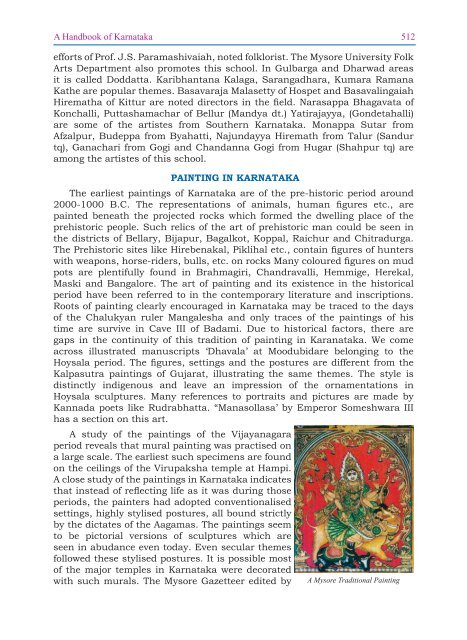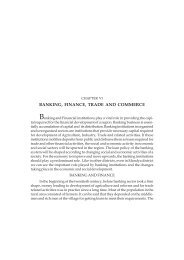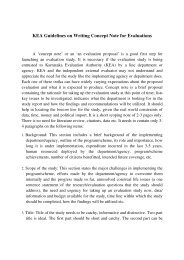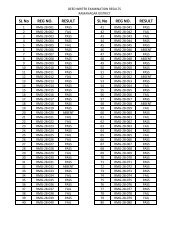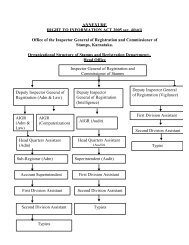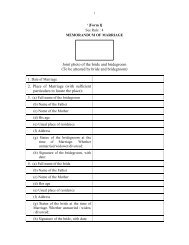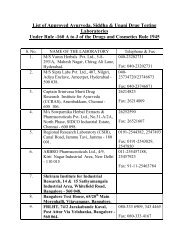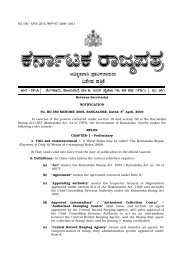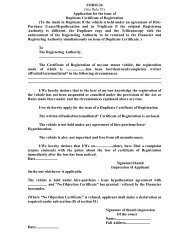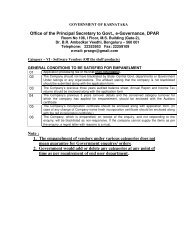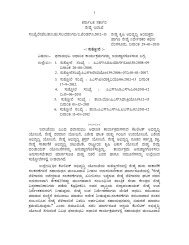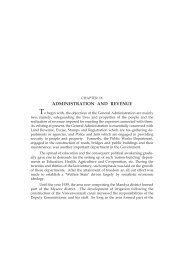Chapter XIII CULTURE - Government of Karnataka
Chapter XIII CULTURE - Government of Karnataka
Chapter XIII CULTURE - Government of Karnataka
You also want an ePaper? Increase the reach of your titles
YUMPU automatically turns print PDFs into web optimized ePapers that Google loves.
A Handbook <strong>of</strong> <strong>Karnataka</strong> 512<br />
efforts <strong>of</strong> Pr<strong>of</strong>. J.S. Paramashivaiah, noted folklorist. The Mysore University Folk<br />
Arts Department also promotes this school. In Gulbarga and Dharwad areas<br />
it is called Doddatta. Karibhantana Kalaga, Sarangadhara, Kumara Ramana<br />
Kathe are popular themes. Basavaraja Malasetty <strong>of</strong> Hospet and Basavalingaiah<br />
Hirematha <strong>of</strong> Kittur are noted directors in the field. Narasappa Bhagavata <strong>of</strong><br />
Konchalli, Puttashamachar <strong>of</strong> Bellur (Mandya dt.) Yatirajayya, (Gondetahalli)<br />
are some <strong>of</strong> the artistes from Southern <strong>Karnataka</strong>. Monappa Sutar from<br />
Afzalpur, Budeppa from Byahatti, Najundayya Hiremath from Talur (Sandur<br />
tq), Ganachari from Gogi and Chandanna Gogi from Hugar (Shahpur tq) are<br />
among the artistes <strong>of</strong> this school.<br />
PAINTING IN KARNATAKA<br />
The earliest paintings <strong>of</strong> <strong>Karnataka</strong> are <strong>of</strong> the pre-historic period around<br />
2000-1000 B.C. The representations <strong>of</strong> animals, human figures etc., are<br />
painted beneath the projected rocks which formed the dwelling place <strong>of</strong> the<br />
prehistoric people. Such relics <strong>of</strong> the art <strong>of</strong> prehistoric man could be seen in<br />
the districts <strong>of</strong> Bellary, Bijapur, Bagalkot, Koppal, Raichur and Chitradurga.<br />
The Prehistoric sites like Hirebenakal, Piklihal etc., contain figures <strong>of</strong> hunters<br />
with weapons, horse-riders, bulls, etc. on rocks Many coloured figures on mud<br />
pots are plentifully found in Brahmagiri, Chandravalli, Hemmige, Herekal,<br />
Maski and Bangalore. The art <strong>of</strong> painting and its existence in the historical<br />
period have been referred to in the contemporary literature and inscriptions.<br />
Roots <strong>of</strong> painting clearly encouraged in <strong>Karnataka</strong> may be traced to the days<br />
<strong>of</strong> the Chalukyan ruler Mangalesha and only traces <strong>of</strong> the paintings <strong>of</strong> his<br />
time are survive in Cave III <strong>of</strong> Badami. Due to historical factors, there are<br />
gaps in the continuity <strong>of</strong> this tradition <strong>of</strong> painting in Karanataka. We come<br />
across illustrated manuscripts ‘Dhavala’ at Moodubidare belonging to the<br />
Hoysala period. The figures, settings and the postures are different from the<br />
Kalpasutra paintings <strong>of</strong> Gujarat, illustrating the same themes. The style is<br />
distinctly indigenous and leave an impression <strong>of</strong> the ornamentations in<br />
Hoysala sculptures. Many references to portraits and pictures are made by<br />
Kannada poets like Rudrabhatta. “Manasollasa’ by Emperor Someshwara III<br />
has a section on this art.<br />
A study <strong>of</strong> the paintings <strong>of</strong> the Vijayanagara<br />
period reveals that mural painting was practised on<br />
a large scale. The earliest such specimens are found<br />
on the ceilings <strong>of</strong> the Virupaksha temple at Hampi.<br />
A close study <strong>of</strong> the paintings in <strong>Karnataka</strong> indicates<br />
that instead <strong>of</strong> reflecting life as it was during those<br />
periods, the painters had adopted conventionalised<br />
settings, highly stylised postures, all bound strictly<br />
by the dictates <strong>of</strong> the Aagamas. The paintings seem<br />
to be pictorial versions <strong>of</strong> sculptures which are<br />
seen in abudance even today. Even secular themes<br />
followed these stylised postures. It is possible most<br />
<strong>of</strong> the major temples in <strong>Karnataka</strong> were decorated<br />
with such murals. The Mysore Gazetteer edited by A Mysore Traditional Painting


